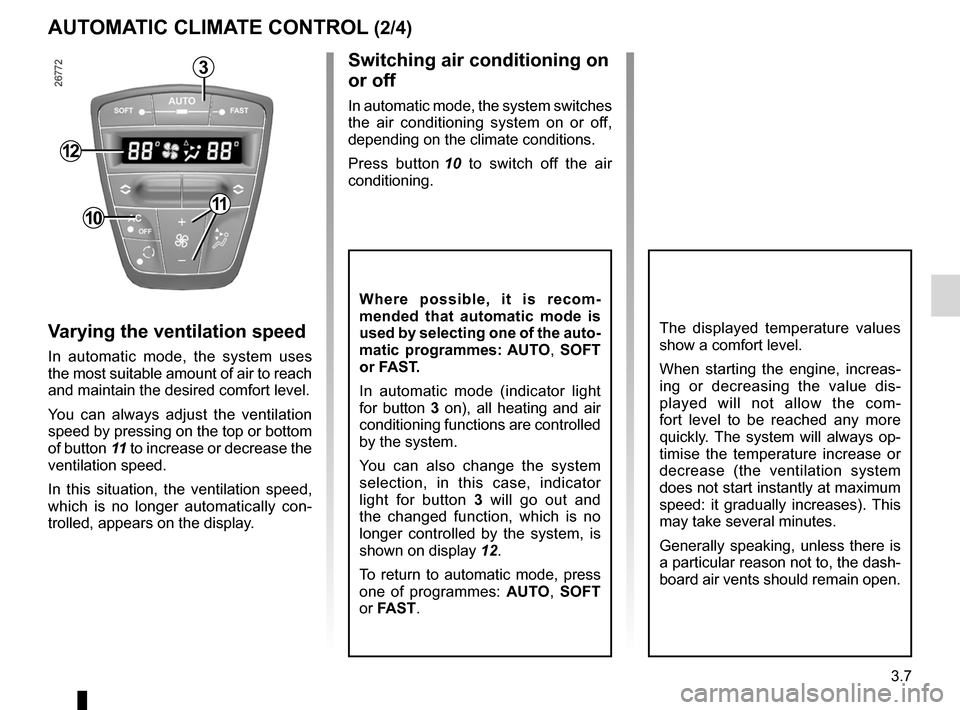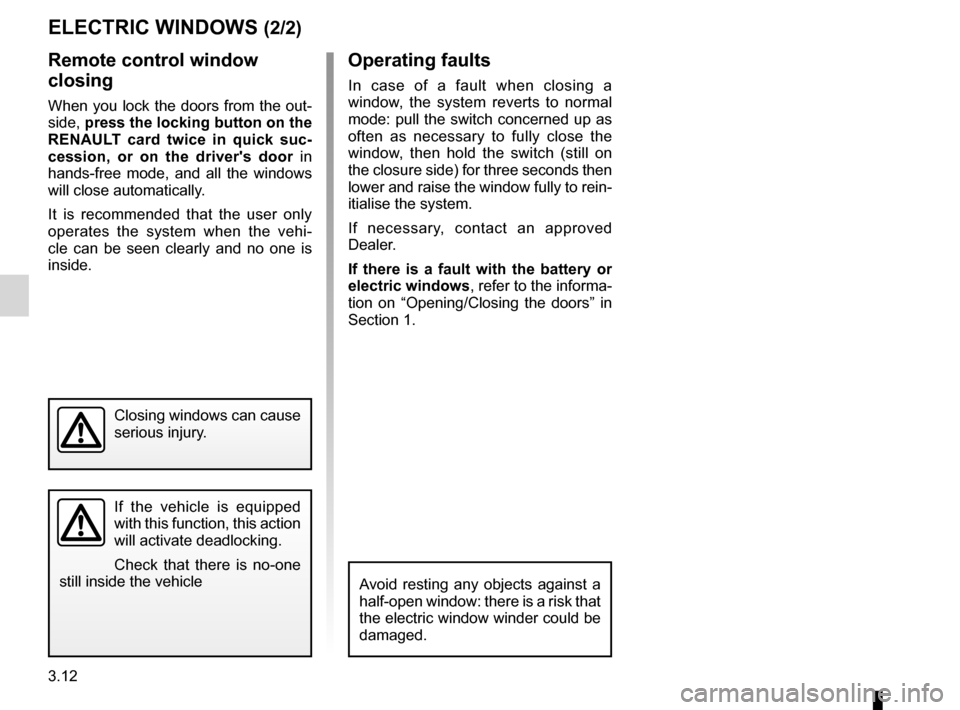2012 RENAULT LAGUNA COUPE ECO mode
[x] Cancel search: ECO modePage 116 of 221

2.38
ENG_UD27633_9
Boîte de vitesses automatique (X91 - B91 - K91 - D91 - Renault)
ENG_NU_939-3_D91_Renault_2
Jaune NoirNoir texte
Parking the vehicle
When the vehicle is stopped, move the
lever to position P while keeping your
foot on the brake pedal: the gearbox is
in neutral and the drive wheels are me-
chanically locked by the driveshaft.
a pply the handbrake or, depending
on the vehicle, ensure that the elec-
tronic parking brake is applied.
Special circumstances
– If the road contours and bends
do not allow you to stay in auto -
matic mode (e.g.: in the mountains),
we recommend that you change to
manual mode.
This will prevent the automatic gear-
box from changing gears repeatedly
when climbing, and permit engine
braking on long descents.
– In cold weather , to prevent the
engine from stalling, wait a few mo-
ments before shifting the selector
lever from position P or N and en -
gaging D or R.
– Vehicles not fitted with traction
control: on a slippery surface or
surface with a low level of adhe -
sion, change to manual mode and
select second gear before starting
the engine to avoid wheelspin when
starting.
Driving in manual mode
With the selector lever in position D,
move the lever to the left. Shifting the
lever repeatedly allows you to change
gears manually:
– To move down through the gears,
push the lever backwards;
– To move up through the gears, push
the lever forwards.
The gear selected is displayed on the
instrument panel.
Special cases
Under certain driving conditions (e.g.
engine protection, electronic stability
program (ESP) operational etc.: ESC),
the “automatic system” may change
gear automatically.
Likewise, to prevent incorrect manoeu -
vres, a gear change may be refused by
the automatic system: in this case the
gear display flashes for a few seconds
as a warning.
aUtoMatIC GeaRBox (2/3)
An impact to the underside
of the vehicle (e.g.: striking
a post, raised kerb or other
street furniture) may result
in damage to the vehicle (e.g.: de -
formation of an axle).
To avoid any risk of accident, have
your vehicle checked by an ap -
proved Dealer.
In very cold weather, the system
may prevent the gears from being
shifted in manual mode until the
gearbox reaches the right tempera-
ture.
Page 124 of 221

air conditioning ..................................... (up to the end of the DU)
heating system ..................................... (up to the end of the DU)
temperature regulation ......................... (up to the end of the DU)
ventilation ............................................. (up to the end of the DU)
air conditioning ..................................... (up to the end of the DU)
3.6
ENG_UD22215_6
Air conditionné automatique (X91 - B91 - K91 - Renault)
ENG_NU_939-3_D91_Renault_3
Jaune NoirNoir texte
Automatic climate control
The controls
1 and 5 Air temperature.
2, 3 and 4 Automatic programmes.
6 Distribution of air in the passenger
compartment.
7 De-icing/demisting of the rear screen
and, depending on the vehicle, the
door mirrors.
8 “Clear View” function.
9 Air recirculation.
10 Air conditioning.
11 Ventilation speed.
12 Display.
Some buttons have an operating
tell-tale which indicates the operat -
ing status.
AuT oMATIc clIMATE coNTRol (1/4)
Automatic mode
The automatic climate control system
guarantees comfort in the passen -
ger compartment and good visibility
(except in the event of extreme condi -
tions), whilst optimising consumption.
The system controls the ventilation
speed, air distribution, air recircula -
tion, and starting and stopping the air
conditioning and air temperature. This
mode consists of a choice of three pro-
grammes:
A uTo : allows the selected comfort
level to be best attained, depending on
the exterior conditions. Press button 3.
SoFT: gently brings the temperature to
the desired comfort level. The comfort
level is then maintained gently and si -
lently. Press button 2.
FAST: emphasises the actions of the
system to reach the desired comfort
level more quickly. Use this programme
when you have passengers in the rear.
Press button 4.
9
10
111
6
12
23
5
4
8
Temperature adjustment
Press either button 1 or 5 to increase
or decrease the temperature. Pressing
button 3 for more than 2 seconds sets
the passenger temperature to the driv-
er’s temperature.
Special note: the highest and lowest
settings allow the system to produce
maximum hot or cold temperature levels
(“LO” and “HI” display on screen 12).
Stopping the system
Press the bottom of button 11 sev -
eral times to stop the system. To start
it, press the top of switch 11 or one of
switches 2, 3 or 4.7
Page 125 of 221

JauneNoirNoir texte
3.7
ENG_UD22215_6
Air conditionné automatique (X91 - B91 - K91 - Renault)
ENG_NU_939-3_D91_Renault_3
AuT oMATIc clIMATE coNTRol (2/4)
The displayed temperature values
show a comfort level.
When starting the engine, increas -
ing or decreasing the value dis -
played will not allow the com -
fort level to be reached any more
quickly. The system will always op-
timise the temperature increase or
decrease (the ventilation system
does not start instantly at maximum
speed: it gradually increases). This
may take several minutes.
Generally speaking, unless there is
a particular reason not to, the dash-
board air vents should remain open.
Switching air conditioning on
or off
In automatic mode, the system switches
the air conditioning system on or off,
depending on the climate conditions.
Press button 10 to switch off the air
conditioning.
Varying the ventilation speed
In automatic mode, the system uses
the most suitable amount of air to reach
and maintain the desired comfort level.
You can always adjust the ventilation
speed by pressing on the top or bottom
of button 11 to increase or decrease the
ventilation speed.
In this situation, the ventilation speed,
which is no longer automatically con -
trolled, appears on the display.
Where possible, it is recom -
mended that automatic mode is
used by selecting one of the auto-
matic programmes: AuT o, SoFT
or FAST.
In automatic mode (indicator light
for button 3 on), all heating and air
conditioning functions are controlled
by the system.
You can also change the system
selection, in this case, indicator
light for button 3 will go out and
the changed function, which is no
longer controlled by the system, is
shown on display 12.
To return to automatic mode, press
one of programmes: AuTo , S o FT
or FAST.
10
3
11
12
Page 128 of 221

3.10
ENG_UD10081_2
Air conditionné : informations et conseils d’utilisation (X91 - B91 - K91 - Renault)
ENG_NU_939-3_D91_Renault_3
Air conditioning: information and advice on use
AIR coNDITIoNINg: information and advice on use
Fuel consumption
You will normally notice an increase
in fuel consumption (especially
when driving in town) when the air
conditioning is operating.
For vehicles fitted with manual air
conditioning, switch off the system
when it is not required.
Advice for reducing
consumption and therefore
helping to preserve the
environment:
Drive with the air vents open and
the windows closed.
If the vehicle has been parked in
the sun, open the doors for a few
moments to let the hot air escape
before starting the engine.
Maintenance
Refer to the Maintenance Document
for your vehicle for the inspection
frequency.operating faults
As a general rule, contact your ap-
proved Dealer in the event of an op-
erating fault:
– reduction in de-icing, demist -
ing or air conditioning per -
formance. This may be caused
by the passenger compartment
filter cartridge becoming clogged;
– no cold air is being produced.
Check that the controls are set
correctly and that the fuses are
sound. Otherwise, switch off the
system.
Advice on use
In some situations, (air conditioning
off, air recirculation activated, venti-
lation speed at zero or low, etc.) you
may notice that condensation starts
to form on the windows and wind -
screen.
If there is condensation, use the
“clear View” function to remove it,
then use the air conditioning in auto-
matic mode to stop it forming again.
If the condensation does not clear,
use the FAST programme.
Do not open the refriger -
ant fluid circuit. The fluid
may damage eyes or skin.
Note
Presence of water under the ve -
hicle. After prolonged use of the air
conditioning system, it is normal for
water to be present under the vehi-
cle. This is caused by condensation.
Page 130 of 221

3.12
ENG_UD22219_4
Lève-vitres électriques (X91 - D91 - Renault)
ENG_NU_939-3_D91_Renault_3
Remote control window
closing
When you lock the doors from the out-
side, press the locking button on the
RENA ulT card twice in quick suc -
cession, or on the driver's door in
hands-free mode, and all the windows
will close automatically.
It is recommended that the user only
operates the system when the vehi -
cle can be seen clearly and no one is
inside.
ElEcTRIc WINDoWS (2/2)
operating faults
In case of a fault when closing a
window, the system reverts to normal
mode: pull the switch concerned up as
often as necessary to fully close the
window, then hold the switch (still on
the closure side) for three seconds then
lower and raise the window fully to rein-
itialise the system.
If necessary, contact an approved
Dealer.
If there is a fault with the battery or
electric windows , refer to the informa-
tion on “Opening/Closing the doors” in
Section 1.
Closing windows can cause
serious injury.
If the vehicle is equipped
with this function, this action
will activate deadlocking.
Check that there is no-one
still inside the vehicle
Avoid resting any objects against a
half-open window: there is a risk that
the electric window winder could be
damaged.